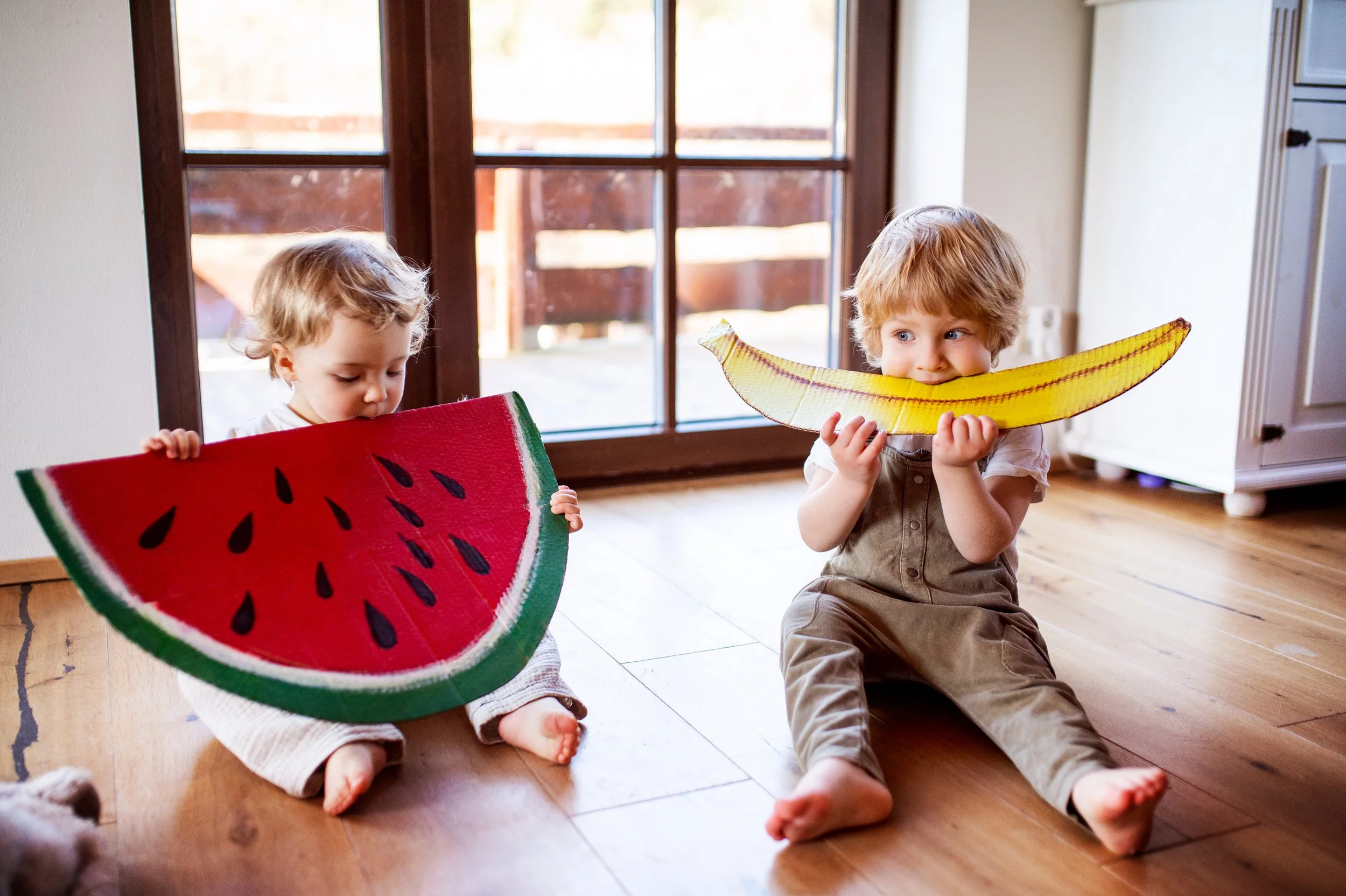Teaching Toddlers to Say 2 Words Together To Ask For What They Want
Most toddlers start combining two words into phrases by the age of two, once they have between 50 and 100 words in their vocabulary.
Phrases that are repeated frequently in your household, like “I love you,” “thank you,” or “all done,” are not considered two-word phrases because your child has memorized them and treats them as single words. A two-word phrase is any new combination of two words your child says, such as “baby eat,” “daddy go,” or “my bubble.”
One way to help your child grow their use of two-word phrases is to encourage them to use these phrases to make requests.
3 Tips for 2 word phrases - toddler at home speech practice
Tip 1 - Practice during snack time
Start by practicing during snack time. This will ensure that your toddler is paying attention, and it can provide a compelling reason for them to try saying a two-word phrase. Instead of offering your child the typical portion size they are used to, give your toddler only one or two pieces, or a half-sized portion of their snack. Then, you can repeatedly model using a two-word phrase to ask for food.
Model what you want them to say. For example, saying “more pear” or “more cookie” for your toddler, then wait to see if they imitate you. Try 2-3 times to have your toddler repeat a phrase, with 5 to 10 seconds of wait time after each. If they don’t imitate you, go ahead and give them the snack. Rest assured that your toddler is making progress toward two-word phrases by listening to your examples. This will take practice!
Tip 2 - Pick a time you can commit to practicing
Another great strategy to ensure your toddler’s progress is to pick a time when you can commit to practicing every day. This ensures that you don’t go crazy trying to be both a teacher and a caregiver all day. It will also help prevent burnout for your child — after all, this is hard work for both of you!
Try practicing two-word phrases to make requests every day during bath time or another activity where your child is confined to a single space. Then, create situations where they need your help to get what they want. For example, instead of putting all their toys in the bath at once, set them aside and give them to your child one by one. Then, model a two-word phrase that your child can say to request the things they want, such as “want duck,” “give me boat,” or “sponge in.”
Tip 3 - Avoid please and thank you
It may seem counterintuitive, but it’s important at this stage to avoid teaching please and thank you. Many parents want their children to use these phrases — of course you want your toddler to be kind-natured and polite! However, from a speech and language development perspective, these words are hard to say and don’t hold a lot of meaning. Learning to say the specific name of an item to tell you exactly what they want has a much greater benefit to a child’s development than learning to say “please” as a general request.
So for now, don’t stress over teaching your child please and thank you. Redirect that energy toward helping them learn to say specific words and phrases to make requests. Once your child can use specific words to ask for most things, then you can switch your attention to focusing on polite words if you’d like.
3 Activities designed to help toddlers put 2 words together to ask for something ↓
Teaching 2 Word Phrases Toddler Activity
Coloring Time!
Materials:
Paper
Crayons/ markers/ something your child likes to color
A clear or open top container that your child can see into for the crayons
Any other motivating art supply that you have (markers, stickers, glue, pencils, etc)
Set-up:
Pick a place in your home where you can color together. If you use glue, pick a washable surface. Take the extra time to set up the area so that it can get messy and you won’t worry about it while you play.
Have paper available for your toddler, plus one or two crayons. The rest of the crayons should be kept in a container out of their reach next to you. Have paper in front of you too so that you can also color.
What to do:
In this activity you will be encouraging your child to use two words to request “more crayons” from you.
When you start, you will give your child only one crayon to color with and wait. When they want more, wait and see if they say “crayon.” If they do, say “oh you want MORE crayons” and give them one. Then wait again and see if they say “MORE crayon.” If they don’t, say it yourself and wait.
In this activity, it is important to only give one item at a time. You can imagine that if you gave your child the entire box of crayons in the beginning, then they would have no reason to request anything from you!
Be careful not to say, “more crayons?” with a question voice. If you do that, your child is more likely to simply nod or say “yeah” than to imitate your sentence. Keep your voice flat like a statement.
You will probably be able to get about 5 opportunities for them to say “more crayon” before they are done doing it. When that happens, color for a while, then introduce another art supply (like washable markers.)
What to say:
When encouraging your toddler to use 2 word phrases during coloring time, it might sound like this:
Child: Crayon.
You: Oh, you want MORE CRAYONS. [waits 5 seconds to see if they say anything]
Child: Crayon.
You: Okay, here are MORE CRAYONS. [gives 1 crayon]
Child: More crayon.
You: Sure, here are MORE CRAYONS. [gives two crayons]
3 Activities designed to help toddlers put 2 words together to ask for something (this activity + 2 more!) ↓
You May Also Like These At Home Speech Therapy Tips And Activities:
Teaching your toddler to follow 1 step directions on their own
Teaching your toddler to answer yes or no questions about what they want
Created In Collaboration By:
Stephanie Keffer, MS CCC-SLP
Stephanie Burgener-Vader, MA CCC-SLP
Melissa Sartori, MS CCC-SLP
Yvette Faire-Bostick, MS CCC-SLP
© 2020-2025. Stephanie Keffer Hatleli, MS CCC-SLP. All Rights Reserved.
The content offered on ToddlerTalk.com is for informational purposes only. Toddler Talk is not engaged in rendering professional advice, whether medical or otherwise, to individual users or their children or families. No content on this site, regardless of date, should ever be used as a substitute for direct medical advice from your doctor, speech language pathologist, or other health professional. By accessing the content on ToddlerTalk.com, you acknowledge and agree that you are accepting the responsibility for your child’s health and well-being. In return for providing you with information related to home speech and language practice, you waive any claims that you or your child may have as a result of utilizing the content on ToddlerTalk.com.



